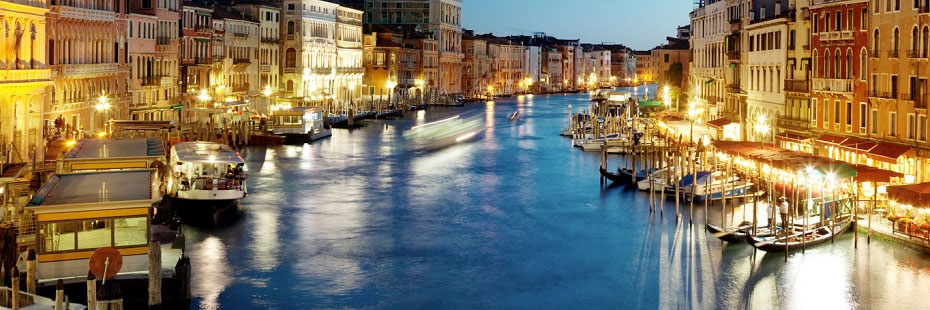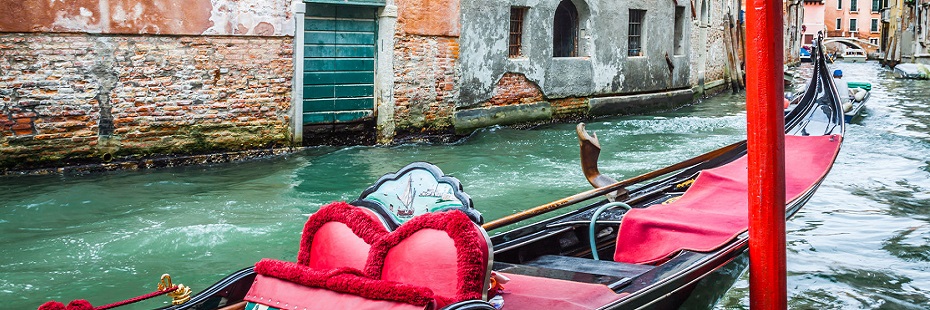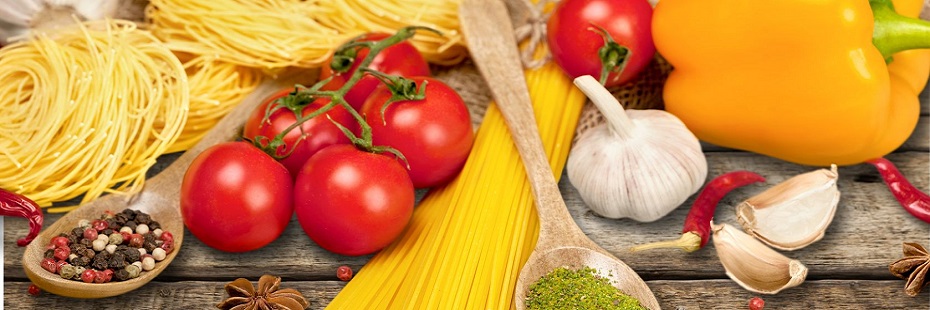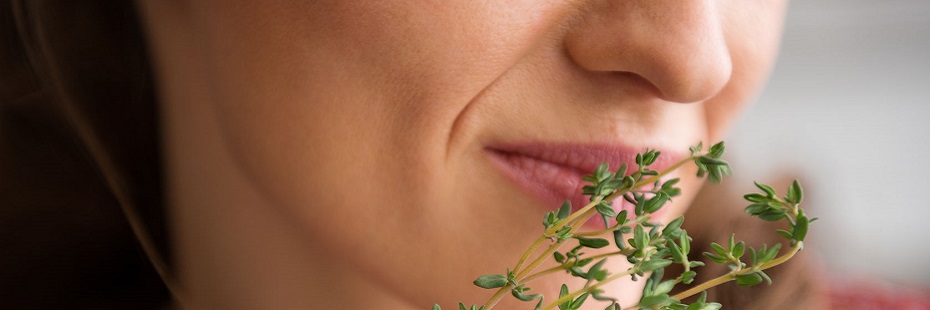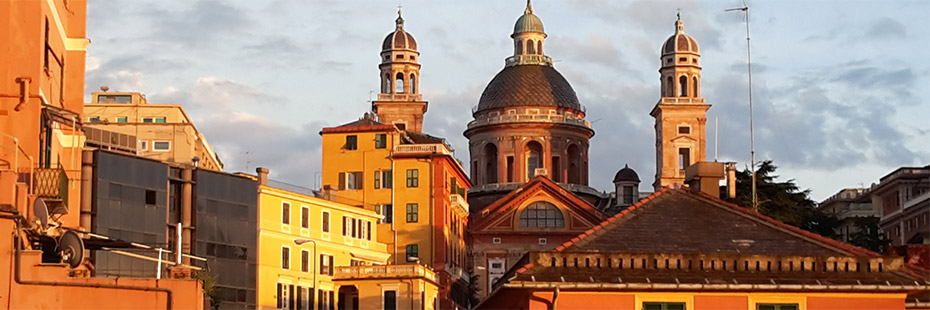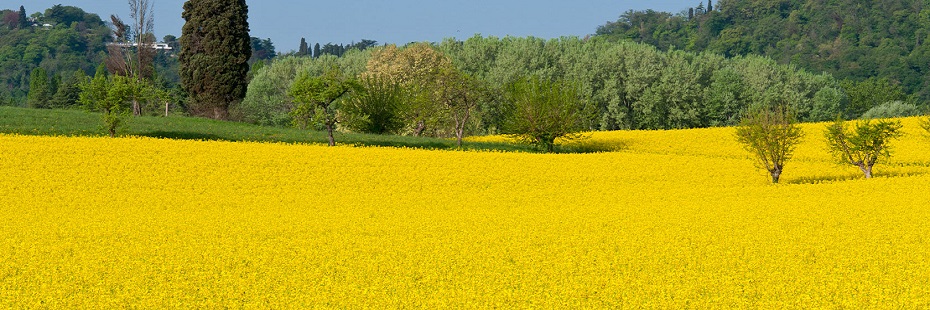La Liguria è una delle regioni più piccole d'Italia. Lunga e affusolata, si srotola fra il mediterraneo e le montagne. Storicamente terra di navigatori, mercanti, coltivatori e pescatori, contribuisce alla cucina italiana con molti piatti, fra cui la fainà.
Conosci la Liguria?
Scorri la pagina per proseguire l'attività... |
Liguria is one of the smallest regions in Italy. Long and narrow, it unwinds between the Mediterranean sea and the mountains. Historically a land of navigators, merchants, farmers and fishermen, it contributes many dishes to the Italian cuisine, including fainà.
Do you know Liguria? Have you ever tasted fainà?
Scroll down for more of the activity... |
|---|
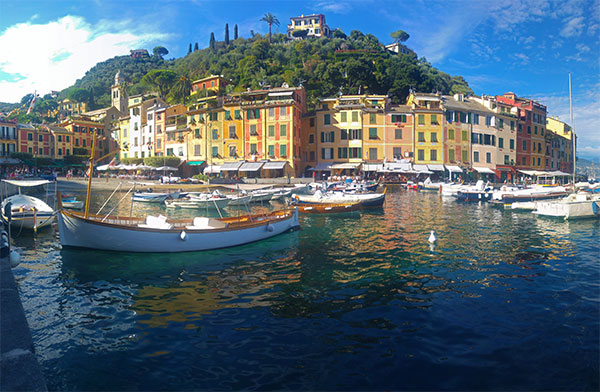
Portofino, Liguria
Share this activity:
In Liguria, vista la forma lunga e stretta, le coltivazioni vengono fatte a "terrazze".
Gli ulivi, i vigneti e il basilico (per il famoso pesto) sono fra le coltivazioni più diffuse.
I piccoli paesini sulla costa hanno dei porticcioli interni dove tirare le barche a terra per proteggerle dal mare in burrasca.
Genova, città capoluogo della Liguria, ha il centro medioevale più grande d'Europa.
Genova fu una Repubblica Marinara dal 1099 al 1797, e nel medioevo divenne una delle maggiori potenze commerciali, navali e finanziarie in Europa. Nel 1407 vide nascere la più antica banca del mondo (Casa delle compere e dei banchi di San Giorgio).
Nel secolo XVI, la tela robusta delle navi a vela e degli abiti dei marinai genovesi era molto apprezzata in Europa, e divenne l'odierno jeans (la parola viene dal francese "bleu de Gênes" ovvero "blu di Genova" = blue jeans).
Alcuni degli artisti liguri più famosi sono: Nicolò Paganini, Fabrizio de Andrè, Ivano Fossati, Paolo Villaggio. |
In Liguria, given its long and narrow shape, crops are grown in "terraces."
Olive trees, vineyards and basil (for the famous pesto) are among the most common crops.
Small villages on the coast have inland marinas where boats can be pulled ashore to protect them from stormy seas.
Genoa, the capital city of Liguria, has the largest medieval center in Europe.
Genoa was a Maritime Republic from 1099 to 1797, and in the Middle Ages it became one of the major commercial, naval and financial powers in Europe. In 1407 it saw the birth of the oldest bank in the world (Casa delle compere e dei banchi di San Giorgio).
In the 16th century, the sturdy fabric of Genoese sailboats and sailors' clothing was highly prized in Europe, and became today's jeans (the word comes from the French "bleu de Gênes" or "blue of Genoa" = blue jeans.)
Some of the most famous Ligurian artists are: Nicolò Paganini, Fabrizio de Andrè, Ivano Fossati, Paolo Villaggio. |
|---|
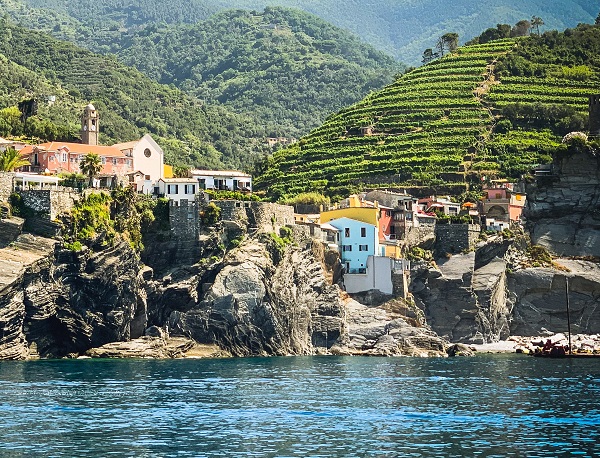
Terracing for Ligurian crops
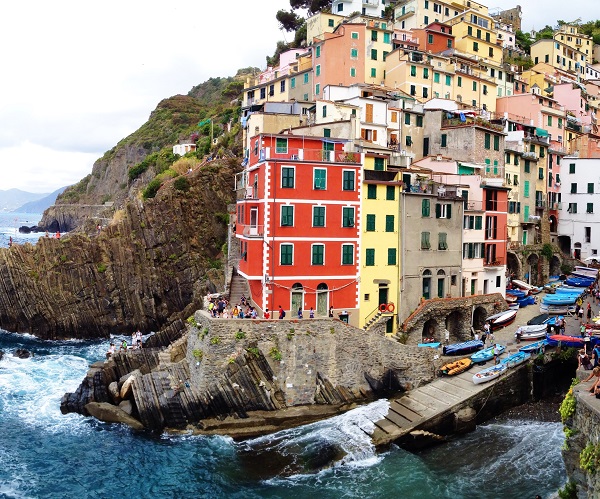
Small village with a ramp to bring boats ashore
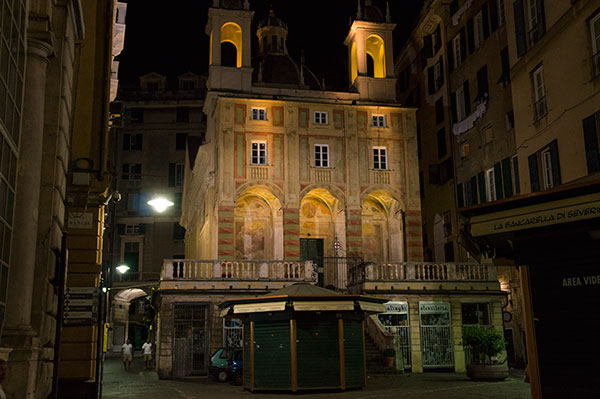
Genoa: a square in the medieval old town
(image courtesy of Paolo Vacchina)
La Liguria è famosa per molti piatti prelibati fra cui la focaccia al formaggio, i pansotti alla salsa di noci, le trofie al pesto, la cima alla genovese, la fainà e molti altri.
Segui questa facile ricetta e prepara anche tu la fainà.
RICETTA DELLA FAINÀ (chiamata anche farinata o farinata di ceci o fainè o cecina)
Leggenda La nascita della farinata risalirebbe a quando le galee genovesi si trovarono coinvolte in una tempesta dopo aver sconfitto la Repubblica Marinara di Pisa nella battaglia della Meloria. Nel trambusto alcuni barilotti d'olio e dei sacchi di ceci si sarebbero rovesciati, inzuppandosi di acqua salata. Poiché le provviste erano in buona parte perdute, si narra che ai marinai venisse proposta una purea di ceci e olio. Alcuni marinai avrebbero rifiutato la poltiglia lasciandola al sole, che asciugando si sarebbe trasformato in una specie di frittella che, assaggiata il giorno successivo dai marinai, sarebbe stata giudicata una prelibatezza. In seguito i genovesi avrebbero migliorato la purea cuocendola in forno e, per schernire gli sconfitti l'avrebbero chiamata "oro di Pisa" (testo tratto da Wikipedia) Ingredienti per 6 persone * 900 ml di acqua a temperatura ambiente * 300 gr di farina di ceci * pepe q. b.
Quantità sufficiente per 3 teglie da 32 cm di diametro
Procedimento Far stemperare la farina di ceci con l'acqua in una ciotola. Lasciare riposare 4 o 5 ore (meglio ancora tutta la notte). Con un cucchiaio togliere la schiuma che si è formata in superficie. Aggiungere l'olio (non tutto perché una parte bisogna lasciarla per ungere le teglie). Aggiungere il sale e lasciar riposare. Ungere le teglie abbondantemente con l'olio d'oliva extra-vergine. Versare parte dell'amalgama ottenuto nella prima teglia. Girare il tutto in modo che l'olio venga in superficie. Infornare a 250 °C per 10 minuti alla base del forno e poi, in posizione più alta, altri 10 o 15 minuti sempre a 250 °C. I tempi di cottura possono cambiare a seconda del forno che si utilizza. A cottura ultimata, spolverare il pepe ed è pronta.
Guarda il video seguente. Puoi capire cosa dice la cuoca? Molte parole sue parole le ritrovi nella leggenda e nella ricetta qua sopra. La cuoca ama mangiare la farinata con la focaccia, alla maniera livornese. |
Liguria is famous for many delicious dishes including focaccia al formaggio, pansotti with walnut sauce, trofie al pesto, cima alla genovese, fainà and many others.
Follow this easy recipe so you too can make fainà.
RECIPE OF FAINÀ (also called farinata or chickpea farinata or fainè or cecina)
Legend The birth of farinata dates back to when Genoese galleys were caught in a storm after defeating the Maritime Republic of Pisa in the Battle of Meloria. In the turmoil some oil barrels and sacks of chickpeas allegedly spilled, getting soaked with salt water. Since the supplies were largely lost, the story goes that the sailors were offered a puree of chickpeas and oil. Some sailors rejected the mush by leaving it in the sun. The mush dried and turned into a kind of pancake that, tasted the following day by the sailors, was judged a delicacy. Later the Genoese improved the puree by baking it in the oven and, to taunt the defeated, called it "gold of Pisa" (text courtesy of Wikipedia)
Ingredients for 6 people * 900 ml of water at room temperature * 300 gr of chickpea flour * pepper to taste.
This quantity is enough for 3 baking pans 32 cm in diameter
Procedure In a bowl, mix the chickpea flour with water. Let stand 4 to 5 hours (better yet, overnight). With a spoon remove the foam that has formed on the surface. Add the oil (not all of it because some must be left to grease the pans). Add the salt and let stand. Grease the pans generously with extra-virgin olive oil. Pour some of the resulting mixture into the first baking pan. Turn it over so that the oil comes to the surface. Bake at 250 °C for 10 minutes at the base of the oven and then, in a higher position, another 10 to 15 minutes, still at 250 °C. Baking times may change depending on the oven you use. When cooked, sprinkle pepper and it is ready.
Watch the following video. Can you understand what the chef is saying? Many of her words can be found in the legend and recipe above. This chef likes to eat farinata with focaccia, Livorno style. |
|---|
Fainà recipe (farinata di ceci)
by GialloZafferano
This video is additional reference material and is not property of CyberItalian.
Should you have any problem viewing it, please
notify us.
Thank you for your patience and collaboration!


